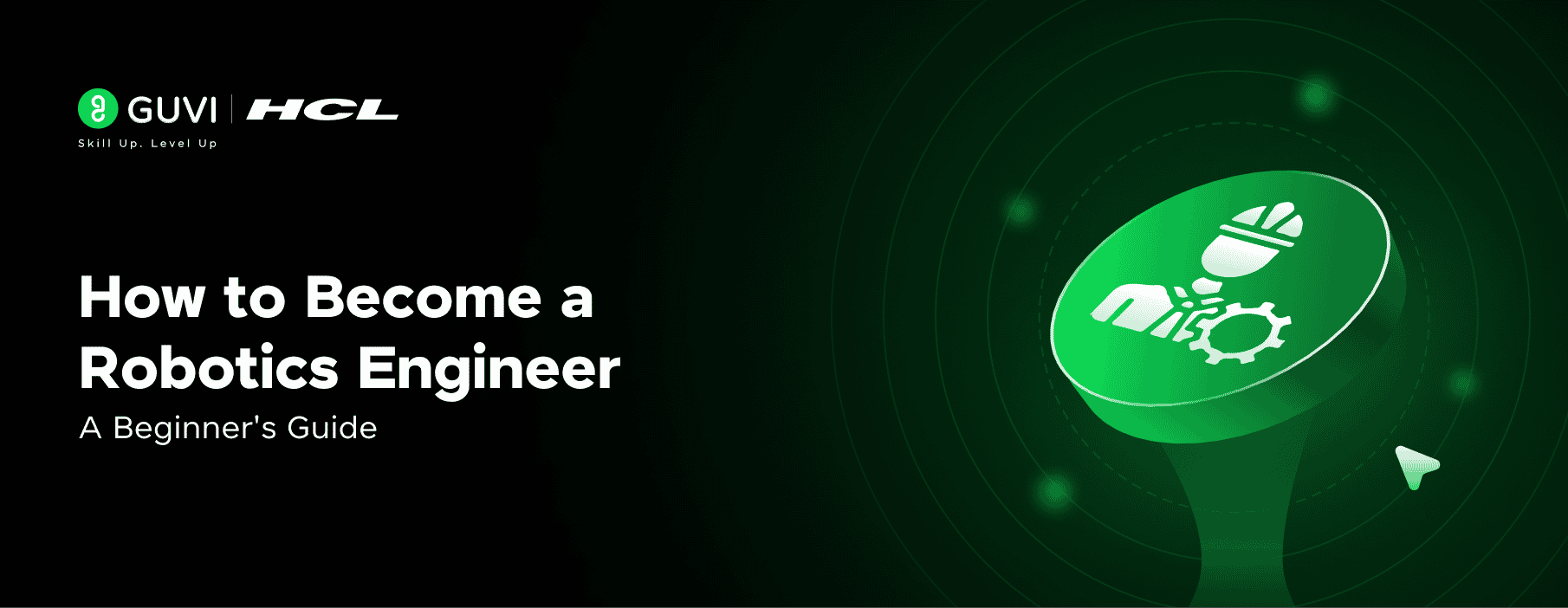
How to Become a Robotics Engineer: A Beginner’s Guide [2025]
Oct 10, 2025 6 Min Read 3634 Views
(Last Updated)
Are you passionate about robots, how they work and what they can do, and how you can work with them? Wel,l you need to become a robotics engineer. Robotics engineering combines various disciplines like mechanical engineering, electrical engineering, and computer science to create machines that work autonomously.
Now, how exactly do you become one? I know that it can be pretty overwhelming with the sheer amount of information out there. But that’s why I’ve written this article, so you don’t have to worry about anything. This beginner’s guide will walk you through the education, skills, and practical steps needed to launch your career in this exciting field. Let’s make you a robotics engineer!
Table of contents
- What does a robotics engineer do?
- 1) Designing and building robots
- 2) Programming and testing robotic systems
- 3) Maintaining and improving robot performance
- Top skills every robotics engineer needs
- 1) Programming and control systems
- 2) Mathematics and problem-solving
- 3) Mechanical and electrical basics
- 4) Teamwork and communication
- How to become a robotics engineer in 2025
- Choose your education path (diploma, degree, or self-taught)
- Enroll in robotics engineering courses
- Learn programming languages like Python or C++
- Work on hands-on projects or join competitions
- Apply for internships or entry-level jobs
- Tools, certifications, and learning resources
- Popular robotics kits and platforms (Arduino, Raspberry Pi)
- Certifications in Python, ROS, or AI
- Top online robotics engineering courses
- Career scope and salary in India
- Entry-Level Robotics Engineer (0–2 years of experience)
- Mid-Level Robotics Engineer (2–5 years of experience)
- Senior Robotics Engineer / Robotics Architect (5+ years of experience)
- Concluding Thoughts…
- FAQs
- Q1. What educational background is required to become a robotics engineer?
- Q2. What programming languages are essential for robotics engineering?
- Q3. How much can a robotics engineer earn in India?
- Q4. What industries hire robotics engineers in India?
- Q5. What skills are most important for a career in robotics engineering?
What does a robotics engineer do?
A robotics engineer operates at the intersection of mechanical, electrical, and computer engineering to create machines that can perform tasks autonomously. Their work spans from conceptualizing robot designs to maintaining complex automated systems. Let’s explore what these professionals do on a day-to-day basis.
![How to Become a Robotics Engineer: A Beginner's Guide [2025] 1 robotics engineer](https://www.guvi.in/blog/wp-content/uploads/2025/06/What-does-a-Robotics-Engineer-do-1200x636.png)
1) Designing and building robots
Robotics engineers begin by researching and determining exactly what a robot will be used for and how it will accomplish its goals. They develop detailed plans and mechanical designs for robotic systems, carefully considering how each component will function. During this phase, they:
- Create mechanical components, including physical structures, joints, and end-effectors
- Design automated systems that increase production and precision levels
- Use computer-aided design (CAD) software to conceive, draft, and simulate a robot’s functionality
- Estimate costs and select the most cost-efficient methods for construction
Before a robot is constructed, engineers perform design calculations to optimize the system’s performance and develop the processes necessary for it to operate correctly. Only after the design phase is complete do they move toward assembling the unit.
2) Programming and testing robotic systems
Once the physical robot is built, robotics engineers must bring it to life through programming:
- They develop software systems that control how the robot operates
- Create algorithms and write code using languages like Python or C++
- Configure the robot to perform specific tasks with precision
- Analyze sensor data and use it to improve the robot’s efficiency
There are several methods robotics engineers use for programming. Teach pendants—handheld devices containing buttons or touchscreens—are the most common, used in over 90% of robots. Other methods include offline programming (simulation) and lead-through demonstration, where an engineer physically moves a robot through desired tasks.
After programming, engineers rigorously test prototypes to validate design concepts and ensure the robot functions as intended. They build, configure, and test robots to make sure they perform safely and effectively.
3) Maintaining and improving robot performance
The work of a robotics engineer doesn’t end after deployment. Maintaining and improving robotic systems is an ongoing responsibility:
- They perform regular inspections and preventative maintenance to keep robots running efficiently
- Analyze and evaluate the systems they’ve created, making adjustments as needed
- Troubleshoot issues and provide technical support
- Update software to enhance performance and address security concerns
Preventive maintenance is crucial for extending a robot’s lifespan and ensuring it performs optimally. Engineers establish maintenance schedules, inspect components for wear, and make necessary adjustments. This proactive approach can increase uptime, improve performance, reduce errors, and save money in the long run.
Top skills every robotics engineer needs
Mastering specific technical and soft skills forms the backbone of success for anyone wondering how to become a robotics engineer. Beyond formal education, these competencies distinguish exceptional robotics professionals from average ones. Let’s examine the essential skills you’ll need to thrive in this dynamic field.
![How to Become a Robotics Engineer: A Beginner's Guide [2025] 2 Top Skills Every Robotics Engineer Needs](https://www.guvi.in/blog/wp-content/uploads/2025/06/‘Top-Skills-Every-Robotics-Engineer-Needs_.jpg)
1) Programming and control systems
Programming is non-negotiable for robotics engineers. You must be proficient in several key languages:
- Python: Popular for its simplicity and versatility, making it ideal for beginners
- C++: Essential for performance-critical applications running at 100+ Hz
- Java: Known for its portability and ease of use
Control systems serve as the “brain” of a robot. These sophisticated systems use algorithms and software to dictate how a robot responds to stimuli. A programmable logic controller (PLC) is a common type of control system that converts electrical signals into physical actions, enabling robots to move and manipulate objects.
According to experts, understanding sensors and actuators is equally important, as these components help robots perceive and respond to their environment. Moreover, effective communication systems are crucial for accurately transmitting commands, feedback, and sensor data.
2) Mathematics and problem-solving
Mathematics is considered one of the only “core” skills in robotics that you cannot simply learn as you go along. At minimum, you need a strong foundation in:
- Algebra and calculus for understanding abstract concepts
- Geometry for kinematics and technical drawing
- Linear algebra for representing probability distributions
In robotics programs, you’ll encounter vector spaces, orthogonal bases, the projection theorem, and matrix factorizations. These mathematical tools allow you to model and reason about uncertainty, which is critical when working with robotics systems that interact with the unpredictable real world.
3) Mechanical and electrical basics
Despite appearing intimidating, electronics fundamentals are essential and approachable without an electrical engineering degree. You should understand:
- Basic circuit concepts (open circuit, closed circuit)
- Voltage (measured in volts) and current (measured in amperes)
- How batteries store DC electricity at set voltages
Consequently, knowledge of mechanical components, including physical structures, joints, and end-effectors, is vital. You’ll need familiarity with tools like multimeters for measuring voltage, current, and resistance, plus soldering skills for creating electrical connections.
4) Teamwork and communication
Robotics is rarely a solo endeavor. As a robotics engineer, you’ll likely work with five or six other engineers, project managers, product developers, and user experience experts. Being a team player is considered essential for success in the field.
Particularly, robotics teams benefit from members with diverse backgrounds, as they bring different perspectives and problem-solving approaches. Regular check-ins and communication help teams stay aligned and on track, especially when working under tight timeframes.
How to become a robotics engineer in 2025
The path to becoming a robotics engineer involves strategic education choices, skill development, and hands-on experience. Entering this exciting field requires dedication, but the journey can be tailored to your specific circumstances and goals. Here’s your roadmap to becoming a robotics engineer in 2025.
![How to Become a Robotics Engineer: A Beginner's Guide [2025] 3 How to Become a Robotics Engineer](https://www.guvi.in/blog/wp-content/uploads/2025/06/How-to-Become-a-Robotics-Engineer.jpg)
1. Choose your education path (diploma, degree, or self-taught)
Getting started in robotics engineering requires choosing the right educational foundation. Consider these options based on your situation:
- Bachelor’s degree: A 4-year degree in robotics engineering, mechanical engineering, electrical engineering, or computer science provides comprehensive knowledge. Carnegie Mellon, Worcester Polytechnic Institute, and Michigan University offer specialized robotics programs.
- Master’s or PhD: For research or specialized roles, advanced degrees can give you an edge, typically taking 2-3 additional years.
- Self-taught route: Although more challenging, you can build skills through online courses, certifications, and personal projects. This path may take 5-8 years to reach professional competency.
For India-based aspirants, engineering degrees from top institutes provide the strongest foundation, with starting salaries ranging from ₹4-8 lakhs annually for fresh graduates.
2. Enroll in robotics engineering courses
Once you’ve chosen your educational path, focus on courses that build your robotics knowledge:
- Core robotics courses covering kinematics, dynamics, and control systems
- Machine learning and artificial intelligence fundamentals
- Mechanical design and electrical systems
- Control theory and embedded systems development
Furthermore, look for programs that include lab components and team projects. Many universities now offer robotics specializations or minors that you can add to related engineering degrees.
3. Learn programming languages like Python or C++
Programming skills are essential for robotics engineers. Focus on mastering these key languages:
- Python: Easier to learn with fewer lines of code required. Excellent for rapid prototyping and testing. Has robust libraries for robotics development.
- C/C++: The “gold standard” in robotics programming. Provides real-time performance and better hardware compatibility. Critical for time-sensitive operations.
Notably, C++ is preferred for performance-critical applications running at 100+ Hz, while Python works well for non-critical components and faster development. Many robotics systems use C++ for core functionality with Python interfaces for ease of use.
4. Work on hands-on projects or join competitions
Theoretical knowledge isn’t enough—practical experience is crucial:
- Build simple robots using platforms like Arduino or Raspberry Pi
- Participate in FIRST Robotics Competition, which reports that 61% of alumni declare engineering or computer science majors
- Join the RoboMaster University Series, which attracts over 400 universities annually
- Create a GitHub portfolio showcasing your projects and code
These competitions offer invaluable experience working in teams to solve complex problems. Additionally, they provide networking opportunities with professional mentors and sponsors.
5. Apply for internships or entry-level jobs
Finally, bridge the gap between education and career:
- Seek robotics internships at companies, research labs, or startups
- Look for positions requiring skills in mechanical design, programming, control systems, and robotics design
- Prepare a portfolio demonstrating your projects and technical skills
- Entry-level robotics positions typically require knowledge in at least three areas: mechanical design, electrical design, robotics programming, control systems, or machine vision
In conclusion, becoming a robotics engineer requires a multi-faceted approach combining formal education, programming expertise, hands-on experience, and continuous learning. The field rewards those who demonstrate both technical proficiency and creative problem-solving abilities.
Tools, certifications, and learning resources
To build your robotics engineering toolkit, you’ll need access to the right hardware, certifications, and learning resources. These building blocks will accelerate your journey into this innovative field.
![How to Become a Robotics Engineer: A Beginner's Guide [2025] 4 Tools Certifications and Learning Resources for Robotics Engineers](https://www.guvi.in/blog/wp-content/uploads/2025/06/Tools-Certifications-and-Learning-Resources-for-Robotics-Engineers_.jpg)
Popular robotics kits and platforms (Arduino, Raspberry Pi)
The Arduino Uno and Raspberry Pi serve as gateway technologies for aspiring robotics engineers:
- Arduino is a microcontroller designed to run single C++ programs with 20 I/O pins (6 analog inputs and 14 digital I/O pins).
- Raspberry Pi functions as a complete single-board computer with significantly more capabilities.
For beginners, robotics kits provide structured learning paths with components for building simple robots like line-followers or obstacle-detecting rovers.
Certifications in Python, ROS, or AI
Enhance your employability with these recognized certifications:
- Python certifications: The PCEP™ (Certified Entry-Level Python Programmer) from the Python Institute validates foundational knowledge
- ROS certifications: The Construct offers Robot Operating System certifications that demonstrate proficiency in this widely used robotics framework
- AI in Robotics certifications: Programs like the Advanced Artificial Intelligence & Robotics certificate from Nexford University cover AI transformation and applications across various industries
These credentials typically range from ₹15,000 to ₹30,000 in India, offering an excellent return on investment for job seekers.
Top online robotics engineering courses
Numerous institutions offer robotics courses for all skill levels:
- HCL GUVI’s Robotics Operating System (ROS) course is designed to help you master practical robotics skills and real-world automation systems from scratch.
- Coursera’s Robotics Specialization covers kinematics, dynamics, and control systems
- “ROS for Beginners” on Udemy teaches fundamentals of this essential robotics framework
These courses often include hands-on projects that build your portfolio while developing practical skills valued by employers in India’s growing robotics sector.
Career scope and salary in India
India’s robotics engineering sector is currently experiencing rapid growth, creating abundant opportunities for those looking to enter this cutting-edge field. Let’s discuss them:
![How to Become a Robotics Engineer: A Beginner's Guide [2025] 5 Career Growth and Advanced Roles@2x](https://www.guvi.in/blog/wp-content/uploads/2025/06/Career-Growth-and-Advanced-Roles@2x-1200x630.png)
1. Entry-Level Robotics Engineer (0–2 years of experience)
Freshers typically begin in roles such as Robotics Intern, Junior Robotics Engineer, or Automation Engineer. These roles involve hands-on work in assembling robotic systems, testing components, and learning tools like ROS (Robot Operating System) and microcontrollers.
- Expected Salary Range: ₹3,50,000 to ₹6,00,000 per annum
- Key Responsibilities:
- Support design and prototyping of robotic systems.
- Program basic automation scripts and control systems.
- Test sensors, actuators, and embedded systems.
- Work under senior engineers to learn tools and standards.
2. Mid-Level Robotics Engineer (2–5 years of experience)
With a few years of experience, engineers move into roles such as Robotics Developer, Control Systems Engineer, or Mechatronics Engineer. These positions require deeper knowledge of machine learning, vision systems, and autonomous navigation.
- Expected Salary Range: ₹6,00,000 to ₹12,00,000 per annum
- Key Responsibilities:
- Design, develop, and optimize robotic subsystems.
- Integrate hardware with software (ROS, C++, Python).
- Implement computer vision, navigation, or motion planning algorithms.
- Work in cross-functional teams for deployment and testing.
3. Senior Robotics Engineer / Robotics Architect (5+ years of experience)
At the senior level, professionals lead R&D, system architecture, and large-scale robotics deployments in industries or research organizations.
- Expected Salary Range: ₹12,00,000 to ₹25,00,000+ per annum
- Key Responsibilities:
- Lead robotics projects from concept to implementation.
- Architect intelligent, scalable, and autonomous robotic systems.
- Mentor junior engineers and manage cross-functional teams.
- Contribute to innovation in AI, embedded systems, and industrial automation.
Concluding Thoughts…
As we conclude, I’m sure you’ve understood that robotics engineering undeniably offers a promising career path in India’s rapidly evolving technological landscape. Throughout this guide, you’ve learned that success in this field requires a combination of formal education, practical skills, and hands-on experience.
Government initiatives like “Make in India” and “Digital India” are accelerating industry growth. For aspiring robotics engineers, the outlook is exceptionally promising as companies across sectors increase their investments in automation technologies. This growing demand translates to competitive salaries and diverse career paths for those with the right education and skills.
Your journey might seem challenging at first, but the combination of technical skills, practical experience, and continuous learning will certainly lead to a rewarding professional path in this innovative field.
FAQs
Q1. What educational background is required to become a robotics engineer?
A bachelor’s degree in robotics engineering, mechanical engineering, electrical engineering, or computer science is typically the minimum requirement. However, some pursue master’s or PhD degrees for advanced roles, while others take a self-taught route through online courses and certifications.
Q2. What programming languages are essential for robotics engineering?
Python and C++ are the most crucial programming languages for robotics engineers. Python is great for rapid prototyping and testing, while C++ is preferred for performance-critical applications and hardware compatibility.
Q3. How much can a robotics engineer earn in India?
Entry-level robotics engineers in India can earn between ₹2 lakh to ₹9 lakh annually. With 3-5 years of experience, salaries can range from ₹2 lakh to ₹9.3 lakh, while those with 6+ years of experience can command ₹2 lakh to ₹30 lakh or higher annually.
Q4. What industries hire robotics engineers in India?
Robotics engineers are in demand across various sectors in India, including manufacturing, healthcare, automotive, aerospace and defense, and logistics. Major employers include TCS, Infosys, Wipro, ABB India, Tata Motors, and government organizations like ISRO and DRDO.
Q5. What skills are most important for a career in robotics engineering?
Key skills for robotics engineers include programming and control systems, mathematics and problem-solving, mechanical and electrical basics, and strong teamwork and communication abilities. Proficiency in tools like Arduino and Raspberry Pi is also valuable.




































Did you enjoy this article?